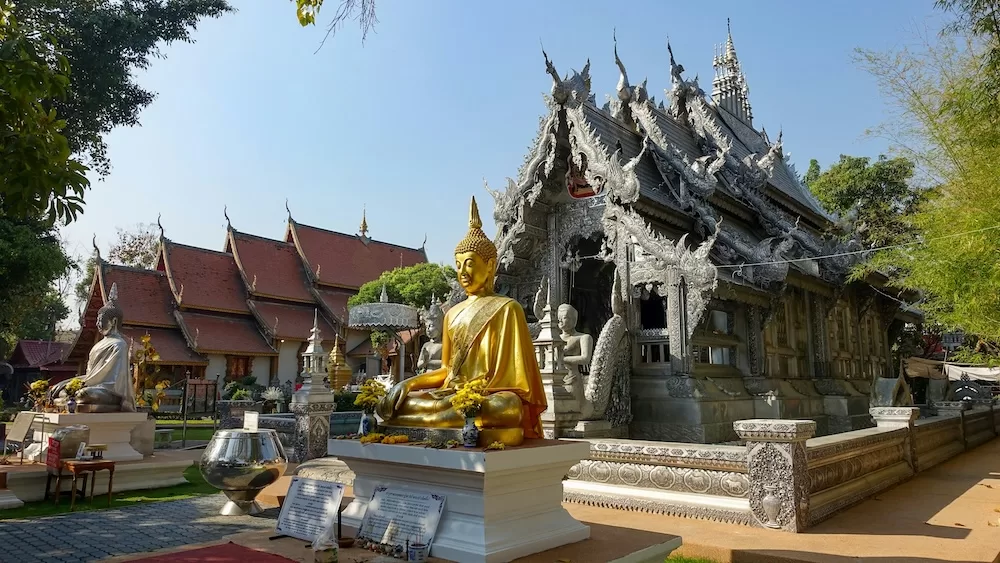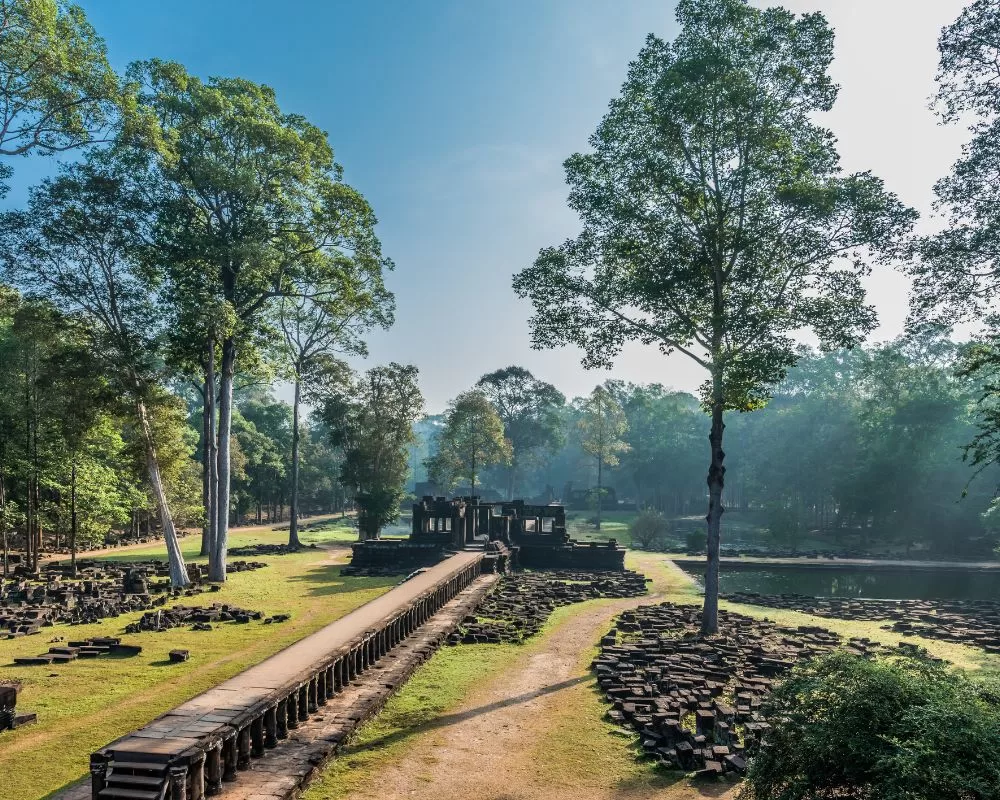
Best Siem Reap Temples: Losing The Crowds
Located in Siem Reap, the former capital of the Khmer Empire was Angkor. Now a labyrinth of temples and a favourite of tourists to explore. However, Siem Reap has far more to offer tourists than Angkor Wat alone. Siem Reap is home to distinctive architecture, Khmer culture, and the most magnificent temples in Cambodia.
Angkor Wat Temple is usually the first thing that springs to mind when someone hears Siem Reap. Hidden behind this well-known symbol are additional temples, each with a unique history, charm and mystery.
So in this post, if you are looking for the best things to do in Siem Reap, beyond Angkor Wat, we explore several lesser-known but no less fascinating temples, including Bayon Temple, Ta Prohm, and Banteay Srei.
Angkor Wat Pass – Ticket price
Official tickets for the Angkor Archaeological Park are available in 1, 3 and 7-day variants. Note: they are only available from Angkor Enterprise, which is the Cambodian Government site. Be aware that other tickets could well be one of the traveller ticket scams.
All of the temples and sites in this post are accessible when buying an Angkor Pass. Tickets can be used for all temples inside Angkor Park and also other temples in Siem Reap such as the Roluos Group, Wat Athvea and Phnom Krom.
Angkor Wat Archaeological Park Ticket Inclusions
The Angkor Pass covers around 24 temples, gates, palaces and terraces including Angkor Wat, Banteay Srei, Pre Rup, Ta Prohm, Bayon, Angkor Thom and several others. Recently Beng Melea Temple was added to the Pass.
Tickets cannot be used for Koh Ker and Phnom Kulen which require a separate ticket. These are charged at $5, $10 and $20 respectively.
Siem Reap Temple and Angkor Wat Entrance Fee
Below are the ticket costs for 2024. You’ll need a pass if you are thinking of visiting the sites of Siem Reap, the pass represents considerable value.
| Pass Duration | Ticket Price (USD) |
|---|---|
| 1-Day Pass | $37 |
| 3-Day Pass | $62 |
| 7-Day Pass | $72 |
Ta Prohm – The Jungle Temple
Opening Hours: 07:30 – 17:30
Ta Prohm Entrance Fee – included in the Angkor Pass
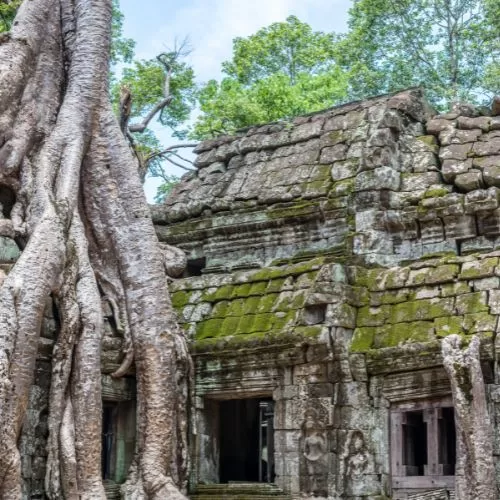
As you walk through the forest, coming upon Ta Prohm, it is understandable why this temple is considered the most-photographed temple in the Angkor Wat complex. Immense trees tower over the ruins as vines wrap themselves around the stone walls, providing stunning portraits and endless moments of fascination.
Built by King Jayavarman VII in the late 12th and early 13th centuries, Ta Prohm was built as a school of Mahayana Buddism and a monastery. The sanctuary is centred around the huge, elevated stone face of Prajnaparamita, the personification of wisdom, whose features were modelled after those of the king’s mother. The temple was destroyed by the Siamese in the 15th century and Ta Prohm has simply been left as it was found. Covered by the jungle and forgotten for many centuries Ta Prohm lay unexplored until 1860 when it was rediscovered by Herri Mouhot, a French botanist.
While the intertwined roots and imposing kapok and fig trees make for phenomenal photos, they also pose challenges for visiting the temple. Barred by thick tree trunks and piles of rubble, some areas are now completely impassable. Other passageways require ducking under roots or turning sideways to squeeze through. Open space can be found in the large central courtyard, but it is slowly being claimed by the surrounding forest canopy.
Top Tip: Visit Ta Prohm in the early morning hours, the light will be filtering through the jungle canopy creating a magical atmosphere.
Fun Fact: Ta Prohm’s popularity has soared in recent years as a result of its appearance in the movie Lara Croft: Tomb Raider.
Be sure to check out the controversial Dinosaur of Ta Prohm – a corner of the Ta Prohm temple with a strange story of its own. A small carving on a crumbling temple wall seems to show a dinosaur. Several different theories have been thrown around – it’s a recently-carved hoax or it’s simply an image portraying a cow or rhino with a palm tree in the background. However, the biggest controversy of all is that the image is evidence that dinosaurs really did live on until much later than previously thought.
Bayon Temple: A Temple of Many Faces
Opening Hours: 07:30 – 17:30
Bayon Temple Entrance Fee – included in the Angkor Pass
The Bayon Temple, constructed during Jayavarman VII’s reign, is the only Buddhist state temple as well as the last to be built in the Angkor Empire. Located at the centre of the royal city of Angkor Thom, Bayon Temple was designed as a mandala cosmic diagram. According to Hindu, Jain and Buddhist practitioners, at the heart of a mandala is the palace of an important deity or Mt. Meru, which is the centre of the universe. Therefore, the Bayon Temple was constructed in the heart of Angkor Thom, and was intended to represent Mt. Meru on earth.
The most distinctive features of Bayon Temple are the towers of smiling faces that surround the temple’s sanctuary. It’s these smiling faces that are the subject of disagreement among historians. One hypothesis is that the tranquil Bayon Temple faces are a representation of the Bodhisattva of compassion known as Lokesvara, and in fact, the host of tranquil visages is often referred to as the “200 faces of Lokesvara”. Another is that the Bayon Temple faces are portraits of King Jayavarman VII, and indeed, they do bear a striking similarity to other statues of the king found throughout the Angkor complex. However, both hypotheses may be true as many Khmer rulers regarded themselves as “god-kings”.

Top Tip: Bayon Temple is a great alternative for a sunrise vantage point without the larger crowds. The east-facing direction is perfect to capture the sunrise from a different viewpoint. Position yourself across from one of the pools at the entrance to the temple and you’ll be able to marvel as the famous faces of Bayon are gradually illuminated as the sun climbs higher in the sky.
Banteay Srei: The Jewel of Angkor
Opening Hours: 07:30 – 17:30
Banteay Srei Entrance Fee – included in the Angkor Pass
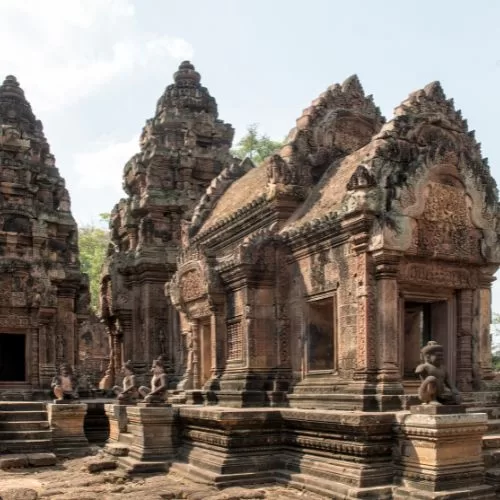
Banteay Srei goes by many nicknames, “The Lady Temple”, “The Tiny Temple” and “The Pink Temple”, an indication of the distinctiveness of this little gem of a temple, which feels so different to the imposing grandeur of the main Angkorian complex. However, you’ll mostly hear it called “the citadel of women,” due to the elaborate decorative carvings of many devatas or minor female deities that grace its walls.
When Banteay Srei was first rediscovered it was thought to date back to the 13th or 14th century due to its refined carvings. However, inscriptions later found at the site place its consecration very precisely on the 22nd of April, 967 A.D. Additionally, it is the only major temple not to be built by a King. Banteay Srei temple was primarily dedicated to the Hindu god Śiva. Nevertheless, the temple buildings appear to be divided along the central east-west axis between those buildings located south of the axis. It is these buildings which are devoted to Śiva, and those north of the axis are devoted to Viṣṇu.
The reddish-coloured sandstone, which gives Banteay Srei its nickname of the “pink” temple, is soft and can be carved like wood. It is due to this softness that there are masses of ornamental decoration covering the building. Every available surface features intricately portrayed stories and motifs.
Top Tip: The site is very exposed and there is little shade from the heat of the day. Therefore, the ideal time to visit Banteay Srei is in the early morning or late afternoon.
Preah Khan Temple: The Holy Sword
Opening Hours: 07:30 – 17:30
Preah Khan Entrance Fee – included in the Angkor Pass
Preah Khan temple is located in the Angkor Archaeological Park and is still largely unrestored. It is one of the larger temple complexes within the historic park. Preah Khan translates to “Holy Sword” in Khmer, named by Jayavarman VII in honour of his battle victory against the invading force of Chams.
Preah Khan was built in the 12th century by King Jayavarman VII, to honour his father. One of the most interesting aspects of the temple is the Preah Khan stele, which is a carving 2 meters by 0.6 meters that features inscriptions on all four sides. Interestingly, the Preah Khan stele pays homage to the three jewels of Buddhism: the Buddha, the Dhamma (Buddhist teachings), and the Sangha (the Buddhist community).
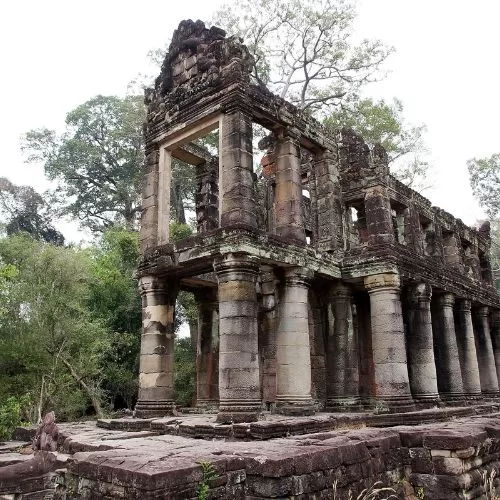
Top Tip: Preah Khan is located in the Angkor Archaeological Park, you won’t find any hotels in the area. Stay in Siem Reap and make sure you visit early in the morning or late afternoon to avoid the crowds.
Ta Som Temple: A Hidden Gem
Opening Hours: 07:30 – 17:30
Ta Som Entrance Fee – included in the Angkor Pass
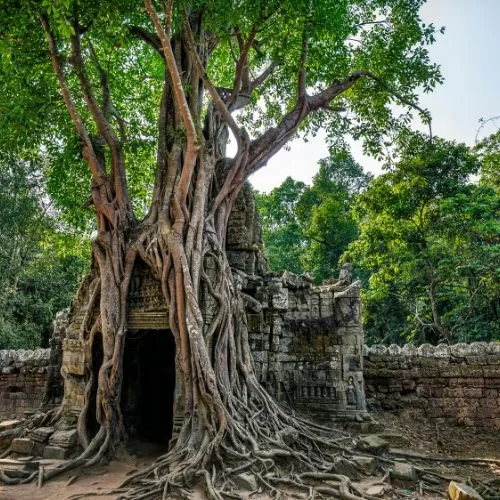
Ta Som was built during the late 12th century by the great King Javayarman VII. Little is known about the purpose of this temple, but it may have been dedicated to the King’s father or one of his teachers. Ta Som was swallowed up by the jungle until the 1930s, when it was cleared out enough for visitors to access the site, but left in its mostly unrestored state.
Ta Som is frequently skipped by tourists even though it is part of the Grand Circuit. Most tourists are more interested in visiting the better-known sites in the park. Nonetheless, if you choose to visit this often-overlooked temple you will be rewarded for the effort. This is because It is quite likely that you’ll have the place to yourself. You’ll be able to take your time exploring the site in peace and take as long as you like to examine the well-preserved bas-reliefs without being jostled by crowds.
Top Tip: The impressive strangler fig embracing the eastern gate is strikingly similar to the tree-covered temple of Ta Prohm made famous in “Tomb Raider”. Even better … you won’t have to stand in line to get a photo, and you’ll have all the time to take as many shots as you’d like.
Phnom Bakheng: The Mountain Top Temple
Opening Hours: 07:30 – 17:30
Phnom Bakheng Entrance Fee – included in the Angkor Pass
Phnom Bakheng is a temple mountain in honour of the Hindu god Shiva and one of the oldest temples in the Angkor Archaeological Park. Thanks to its position on a 60-meter-high hill, Phnom Bakheng has become a very popular tourist spot for its magnificent sunset views over Angkor Wat.
Phnom means hill or mountain in English and as such, it was built on the top of a hill by King Yasovarman at the end of the 9th century. Originally, the temple was built with 108 towers which were arranged to symbolise the four lunar phases. Sadly, many of these towers have long since collapsed. Phnom Bakheng was built to symbolise Mount Meru, the mythical home of the Hindu gods. Additionally, the temple’s pyramid was built with seven layers to represent the seven heavens.

Top Tip: The majority of tourists will flock to Phnom Bakheng for sunset, however, an alternative is to head to Phnom Krom. Very few people take the time to visit Phnom Krom and this alone makes it worth a visit. At Phnom Krom, you can see a stunning sunset whilst avoiding the crowds watching the sun go down at Phnom Bakheng.
There were thousands of temples built by the ancient Khmer people. They were prolific builders who built a vast empire during their reign. Most visitors to Cambodia know about Angkor Wat and a few of the other popular temples such as Bayon and Ta Prohm. But what they don’t know is that there are many temples to visit in the Siem Reap province, and neighbouring provinces in Cambodia. So take the time to head off the beaten track, and you will be rewarded with inspiring landscapes that conjure up dramatic scenes from any “Indiana Jones” movie.
Essential Travel Toolkit
🚖 Rideshare Apps – The most complete guide to Rideshare, Ride-hailing and taxis in Southeast Asia.
🚞 12Go.com – The easiest way to book transport, public or private in Southeast Asia, Japan and Beyond.
🏨 Trip.com – Consistently great accommodation and hotel deals.
🛩️ Trip.com – Get the best flight deals.
🚙 Trip.com – Find your perfect rental car.
🗺️ Getyourguide.com – Looking for an amazing local guide or tour. Get Your Guide will have something for everyone.
🗺️ Viator.com – Easily book tours and experiences at the lowest rate. Amazing options all over the world.
👨💻 NordVPN.com – Reliable VPN service that is guaranteed to keep you and your data safe anywhere in the world.
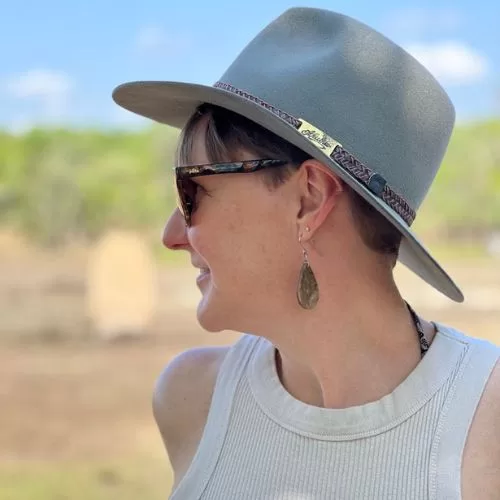
Wendy is a traveller, writer, and photographer with an insatiable curiosity for the world. Her journey, spanning South Africa, the UK, and now Australia, infuses her work with a rich tapestry of experiences. Join her on Getting Lost Again as she shares her creative perspective and passion for overland travel alongside Dan.

